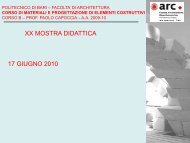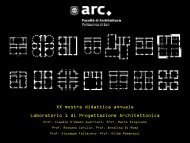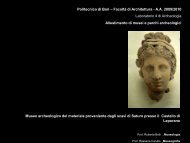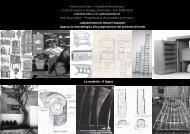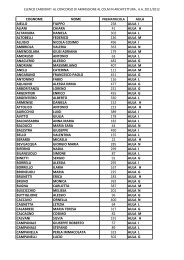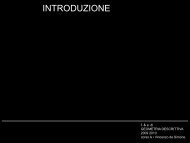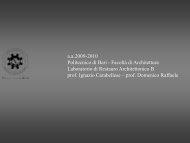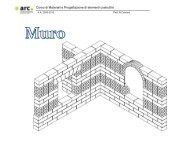Scarica il file pdf - Politecnico di Bari
Scarica il file pdf - Politecnico di Bari
Scarica il file pdf - Politecnico di Bari
You also want an ePaper? Increase the reach of your titles
YUMPU automatically turns print PDFs into web optimized ePapers that Google loves.
Iscrizione al corsoLe iscrizioni avvengono obbligatoriamentesulla piattaforma e-learning entro i primi<strong>di</strong>eci giorni dall’inizio dei corsi.Modalità d’esamePer sostenere l’esame è necessario:• elaborare in forma definitiva leesercitazioni sv<strong>il</strong>uppate durante <strong>il</strong> semestreattraverso la presentazione in formato<strong>di</strong>gitale e su supporto cartaceo in formatoA3 dei materiali prodotti anche contecniche tra<strong>di</strong>zionali;• partecipare con profitto al seminario<strong>di</strong>dattici <strong>di</strong> fine semestre.L’esame è basato su un colloquio nel qualel’allievo, presentando gli elaborati delleesercitazioni, dà prova della conoscenzacritica degli argomenti trattati nel corsodelle lezioni.Fondamenti <strong>di</strong> informaticaBasic Computer ScienceIng-Inf 05-5 Cfu1° anno / corso semestrale (II semestre)Area <strong>di</strong>dattica III:Tecniche <strong>di</strong> rappresentazione emodellazione del prodotto industriale:• Icar 17, Disegno• Ing-Inf 05, Sistemi <strong>di</strong> elaborazione delleinformazioniTommaso Di NoiaFinalità e contenuti <strong>di</strong>sciplinariIl corso introduce gli allievi ai fondamentidell’informatica. Esso è strutturato con unapproccio “web centrico”, così da fornireagli allievi elementi attuali ed innovativi,pur mantenendo i contenuti tipici <strong>di</strong> base.Le lezioni riguarderanno i seguentiargomenti:Architetture hardware e software: struttura<strong>di</strong> un sistema <strong>di</strong> calcolo-Unità funzionali ebus. Il modello <strong>di</strong> Von Neumann. Unitàcentrale, memoria, interfaccia <strong>di</strong> I/O, unitàperiferiche. esecuzione delle istruzioni.Linguaggio assemblatore e traduzione.Sistema operativo- Classificazione deisistemi operativi. Macchine virtuali esistema operativo. Modalità <strong>di</strong>funzionamento del processore: statoutente e stato supervisore. Organizzazionea livelli <strong>di</strong> un sistema operativo. Il nucleo ela gestione dei processi. La gestione dellamemoria. Il f<strong>il</strong>e system. L’interpretecoman<strong>di</strong> e l’interfaccia utente.Algoritmi e strutture dati: Algoritmi:proprietà, definizione, linguaggi. Strutture<strong>di</strong> controllo. Rappresentazione deglialgoritmi. Introduzione alle problematichedella progettazione e della verifica. Tipi <strong>di</strong>dati. Struttura <strong>di</strong> programma. Funzioni.Analisi e progetto <strong>di</strong> algoritmi e strutturedati.Applicazioni: Trasmissione dati, reti locali egeografiche. Modello ISO/OSI e TCP/IP.Protocollo HTTP. archivi e basi <strong>di</strong> dati:modello relazionale ed elementi <strong>di</strong> SQL.Accesso a DBMS via web. Elementi <strong>di</strong> teoriae tecniche <strong>di</strong> elaborazione delle immagini.Linguaggi <strong>di</strong> riferimento: In accordo conl’impostazione del corso, linguaggio <strong>di</strong>riferimento sarà VBscript. Verranno fornitiinoltre elementi <strong>di</strong> linguaggi <strong>di</strong> markup:HTML, XML, SVG (per la parte grafica).Esercitazioni. Le esercitazioni sono parteintegrante del corso.Aims and contentsThe course introduces the students to thebasics of computer science. It is structuredwith a “web centric” approach, so as toprovide actual and innovative elementswh<strong>il</strong>e maintaining the typical contents of abasic course.The lessons concern the following topics:Hardware and software architecture :structure of a system of calculation-Functional unity and bus. The VonNeumann model. Central unity, memory,interface of I/O, peripheral unity. Executionof instructions. Assembler language andtranslation. Operating system-Classificationof operational systems. Virtual machinesand operating systems. Formality ofoperation of the processor: consumer stateand supervisor state. Levels of organizationof an operating system. The nucleus andthe management of trials. The managementof memory. The f<strong>il</strong>e system. The interpretercommands and the user interface.Algorithms and data structures:Algorithms: ownership, definition,languages. Control structures.Representation of algorithms. Introductionto the problem list of planning and theverification. Types of data. Structure ofprograms. Functions. Analysis and projectof algorithms and data structures.Applications: Data transmission, local andgeographical nets. Model ISO/OSI andTCP/IP. Protocol HTTP. f<strong>il</strong>es and databases :relative model and elements of SQL. Accessto DBMS by web. Elements of theory andtechniques of elaboration of images.Languages of reference: In accord with theformulation of the course, the language ofreference w<strong>il</strong>l be VBscript. Some elementsof mark-up languages w<strong>il</strong>l also becovered:HTML, XML, SVG (for the graphic part).Exercises. The exercises are an integral partof the course.Articolazione delle attività <strong>di</strong>datticheLezioni frontali, esercitazioni assistite,laboratorio.Articulation of the educational activitiesLessons, assisted exercises, laboratoryIscrizione al corsoLe iscrizioni avvengono obbligatoriamentesulla piattaforma e-learning entro i primi<strong>di</strong>eci giorni dall’inizio dei corsi.Modalità d’esameL’esame si basa sulla <strong>di</strong>scussione <strong>di</strong> unproject work e una prova orale.44.3.20 Progetti <strong>di</strong>dattici 1° anno143




